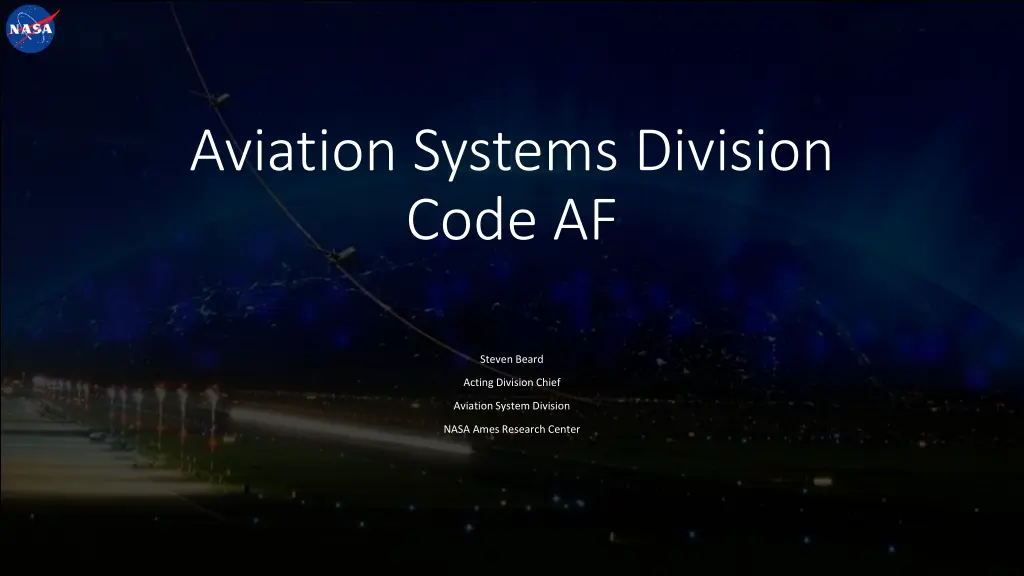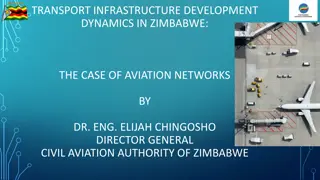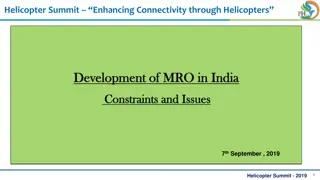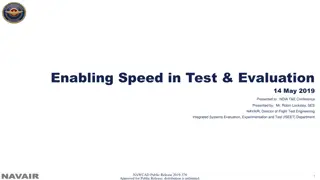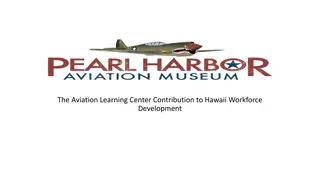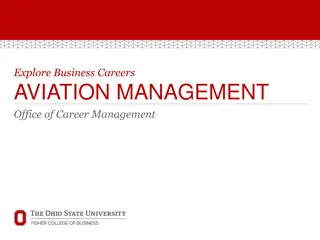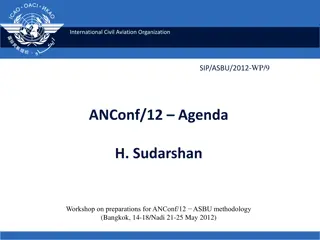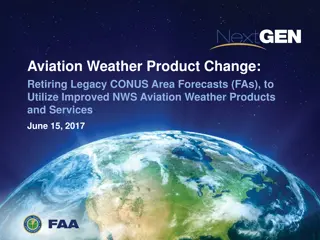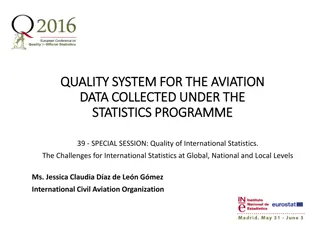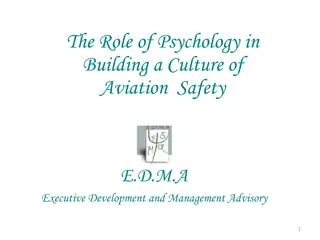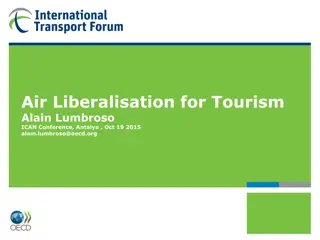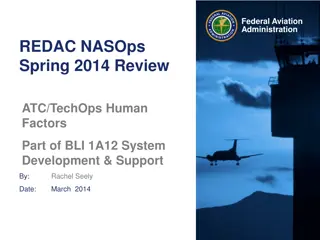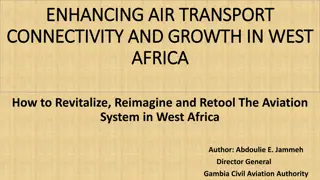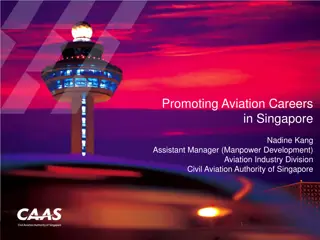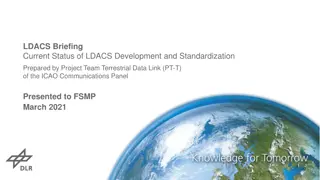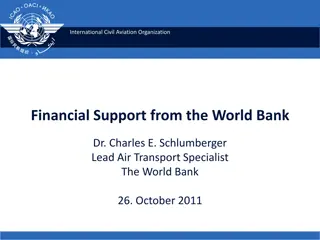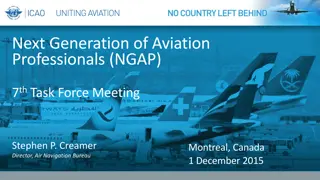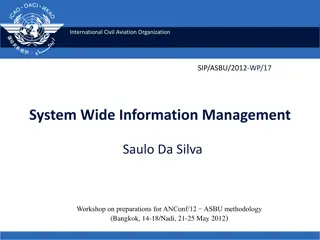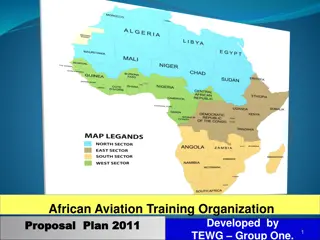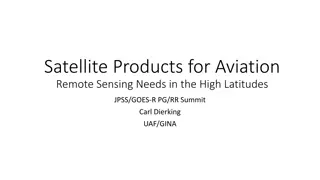Revolutionizing Aviation Systems: Future Innovations Unveiled
Explore cutting-edge advancements in aviation systems from NASA's Ames Research Center, led by Acting Division Chief Steven Beard. Discover how aerospace technology is shaping the future of air travel and enhancing safety and efficiency in the skies.
Download Presentation

Please find below an Image/Link to download the presentation.
The content on the website is provided AS IS for your information and personal use only. It may not be sold, licensed, or shared on other websites without obtaining consent from the author.If you encounter any issues during the download, it is possible that the publisher has removed the file from their server.
You are allowed to download the files provided on this website for personal or commercial use, subject to the condition that they are used lawfully. All files are the property of their respective owners.
The content on the website is provided AS IS for your information and personal use only. It may not be sold, licensed, or shared on other websites without obtaining consent from the author.
E N D
Presentation Transcript
Aviation Systems Division Code AF Steven Beard Acting Division Chief Aviation System Division NASA Ames Research Center
Major Research and Development Areas Major Research and Development Areas The Aviation Systems Division conducts airspace research to enable the transformation of the National Airspace System (NAS). Research activities include developing concept of operations, fast-time simulations, human-in-the-loop real-time simulations, ATM decision software support tools, flight demonstration and field demonstration deployment support. North Texas Research Station NASA Ames Research Center NTX Research Station NASA research assets embedded in a high-demand, varied operational air transport environment Dallas/Fort Worth International 647,834 flights in 2022 3rd among US airports (per ASPM) Access to ARTCC, TRACON, Towers, 3 air carrier AOCs (American, Envoy and Southwest), and 2 major airports all within 12 miles. Supports NASA air traffic research activities from concept development through operational field evaluation. Dallas Love Field 173,856 flights in 2022 33rd among US airports (per ASPM) DFW Terminal RADAR Approach CONtrol (TRACON) (D10) American Airlines More than 165 million passengers in 2022 1st among US air carriers Fort Worth Air Route Traffic Control Center (ARTCC) (ZFW) Southwest Airlines More than 126 million passengers in 2022 3rd among US air carriers FAA Southwest Region Offices
Advanced Capabilities for Emergency Response Operations (ACERO) HALE SATELLITE AIR TACTICAL GROUP SUPERVISOR REMOTE SENSING DAYTIME OPERATIONS NIGHTTIME OPERATIONS TERRESTRIAL COMMUNICATIONS TANKER PILOTED HELICOPTER REMOTELY PILOTED HELICOPTER SEARCH AND RESCUE LOGISTICS AIRCRAFT SAFETY DECISION SUPPORT AERIAL IGNITION WILDFIRE AIRSPACE MANAGEMENT Incoming Aircraft GOAL: Develop, demonstrate, and transition to operations, emerging aviation technologies to identify, monitor, and suppress wildland fires, as a means to enhance safety, improve efficiency, and prevent economic loss. 4
Digital Information Platform (DIP) Digital Information Platform (DIP) NASA Led DIP-Enabled Services for Sustainability Industry Led Partner Service Evaluations University Challenges Ground and flight deck services for improving sustainability of aviation operations Integration and demonstration of Partner services with DIP for validation of the platform Development of innovative AI/ML solution for aviation services SFNP-Ops Demos PS Evals Reference Platform and Services Development of a cloud-based, digital platform and building block services for flight operators and service consumers SFNP-Ops = Sustainable Flight National Partnerships - Operations
Advanced Air Mobility (AAM) Subproject Wildfire Fighting Operations On Demand Air-Taxi Rural Operations Urban Operations Regional Network Inter-City eV/STOL Cargo Delivery Airport Transfer Cargo Delivery Air Ambulance High Density Corridor Medical Supply Delivery Distribution Center/Warehouse Fleet Operations Inter-city eCTOL Small Package Delivery Cross-metro Transfer Safe, sustainable, affordable, and accessible aviation for transformational local and intraregional missions 6
Pathfinding for Airspace with Autonomous Vehicles Pathfinding for Airspace with Autonomous Vehicles (PAAV) Subproject (PAAV) Subproject Goal: Enable seamless, scalable, and robust integration of increasingly autonomous UAS cargo operations into the National Airspace System (NAS) Notional Demo Scenario GCS Simulated * weather avoidance Need: Industry has indicated significant interest in regional UAS cargo operations using (e.g. Caravan- or ATR-size aircraft) and a need for remotely piloted (1:1) operations and a pathway to remotely supervised (m:N) operations Crows Landin g Crows Landing Simulated* conflict avoidance Visual approach to Visalia via traffic pattern to runway 30 Primary use case is regional, point-to-point cargo transportation served by turboprop and regional jet aircraft with a payload of 1 to 10 tons KWVI Hollister KCVH Simulated* contingency, forcing diversion to Hollister X KSNS KMRY Crewed Segments Autonomous Segments with Crew Supervision
Urban Air Mobility (UAM) Subproject Urban Air Mobility (UAM) Subproject Motivation o There is no current airspace system to manage scalable UAM operations. The current ATM system relies on traditional NAS protocols with voice-focused ATC which is not scalable UAM Objectives o Help ensure the airspace is ready when the vehicles are ready o Empower US-based airspace partners to participate early and take a leading role in spreading the NASA-fostered concepts UAM Approach o Investigate the impact of tactical separation provision layer and collision avoidance layer on the safety of UAM operations with various separation standards o Research on interactions between different conflict management layers o Identify vertiport functionality required to support future UAM operations o Advance the demand capacity balancing concept developed for future UAM operations Evolving the airspace towards integration with the National Airspace (NAS), enabling UAM operations
Extensible Traffic Management ( Extensible Traffic Management (xTM xTM) Subproject ) Subproject xTM Maturation and Expansion xTM and ATS Integration Expand to ETM (Cooperative Operating Practices) Increase xTM coordination with ATS to improve the flexibility and efficiency of xTM operations Mature UTM BVLOS The Cooperative Operating Practice (COPs) for high- altitude operations based on the UTM construct. Operational plan sharing Operational plan updating and wait-n-see strategy Strategic deconfliction: fallback, agreement, negotiation Explore Space Launch & Recovery
SHERL CK DATA WAREHOUSE AF Software Facility AF Software Facility Freddie - The Federated Airspace Management Framework (Freddie) is a NASA software implementation of an advanced, collaborative, digital, and automated approach to managing air traffic within the airspace. Extends NASA s UTM Core capabilities and harmonizes algorithms and concepts within new UTM-inspired aviation domains such as Urban Air Mobility, High-E Traffic Management, Space Traffic Management. Air Traffic Management Test Bed - Highly scalable, inter-connected simulation and modeling platform to evaluate current and emerging vehicles and airspace management technologies and accelerate the introduction of these advanced technologies in the National Airspace System (NAS). Sherlock Data Warehouse enterprise platform for reliable NAS-wide ATM data collection, processing, archival, and delivery leveraging structured Big Data technologies and a tool suite for machine learning and data science. The data includes years of flight, weather, traffic management and facility report data. WorldWind - NASA-developed, publicly-available, highly-scalable open-source software development kit (SDK) for assisting developers in the creation of geographical information systems (GISs). Its SDK is a powerful tool used by software engineers to build their own GIS applications. WorldWind is used to integrate, analyze, and display a wide-range of airspace, surveillance, weather and other ATM data.
Scalable AI & Sensible ML for ATM Scalable AI & Sensible ML for ATM ML based trajectory prediction: Superior performance of ML models that combine physics-based modeling with data-driven methods over traditional physics only models for trajectory prediction. ML models learn the mapping from prior (historical) flights to their correct a/c APM parameters (e.g., drag coefficients) and provide superior ETA predictions. Retain the physics-based models (for explainability and bounded output behavior) but optimize the model coefficients- thereby exploiting the power of both methods. Tech pull from FAA NextGen Relevant data driven use-cases (e.g., Traffic Management Initiatives) Exploit abundance of Aviation data (e.g., Sherlock), massive computing power (GPUs) and transformer-based ML models (e.g., chatGPT) Powered by AF core technology + emerging AI/ML tech + NASA supercomputing resources Runway Configuration Assistance: Using historical data on runway configuration decisions and prevailing conditions (e.g., surface wind direction), build a ML model to accurately predict the runway configuration (as historically set by the controller/FLMs) and recommend better options (using a RL method). ML model learns which actions (configurations) are good/bad purely based on historical decisions and outcomes (in terms of delays and traffic flow). The method is model-free and does not require an accurate simulator of surface operations. ATCSCC Webinar transcription: Accurate automated transcription of FAA command center webinar audio and utilize state of the art NLP/NLU methods to extract relevant context and information from the transcript (e.g., weather related events, delay programs). With the recent rapid advances made in speech 2 text (e.g., Google), piggy-back on the baseline models and build custom models trained on Aviation language and ATM phraseology.
Scalable AI & Sensible ML for ATM Scalable AI & Sensible ML for ATM ML based trajectory prediction: Superior performance of ML models that combine physics-based modeling with data-driven methods over traditional physics only models for trajectory prediction. ML models learn the mapping from prior (historical) flights to their correct a/c APM parameters (e.g., drag coefficients) and provide superior ETA predictions. Retain the physics-based models (for explainability and bounded output behavior) but optimize the model coefficients- thereby exploiting the power of both methods. Tech pull from FAA NextGen Relevant data driven use-cases (e.g., Traffic Management Initiatives) Exploit abundance of Aviation data (e.g., Sherlock), massive computing power (GPUs) and transformer-based ML models (e.g., chatGPT) Powered by AF core technology + emerging AI/ML tech + NASA supercomputing resources Runway Configuration Assistance: Using historical data on runway configuration decisions and prevailing conditions (e.g., surface wind direction), build a ML model to accurately predict the runway configuration (as historically set by the controller/FLMs) and recommend better options (using a RL method). ML model learns which actions (configurations) are good/bad purely based on historical decisions and outcomes (in terms of delays and traffic flow). The method is model-free and does not require an accurate simulator of surface operations. ATCSCC Webinar transcription: Accurate automated transcription of FAA command center webinar audio and utilize state of the art NLP/NLU methods to extract relevant context and information from the transcript (e.g., weather related events, delay programs). With the recent rapid advances made in speech 2 text (e.g., Google), piggy-back on the baseline models and build custom models trained on Aviation language and ATM phraseology.
